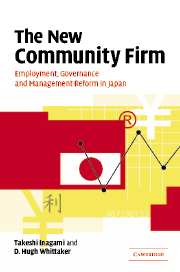Book contents
- Frontmatter
- Contents
- List of figures
- List of tables
- Preface
- Acknowledgements
- Part 1 The End of the Community Firm?
- Part 2 Hitachi: ‘Here, the Future’
- 8 Hitachi: A Dancing Giant
- 9 A Victim of its Own Success?
- 10 Organization Reform
- 11 Recasting the Employment Relationship
- 12 The Impact on Industrial Relations
- 13 Evaluation
- Part 3 The Reformed Model
- Appendix: Changes in Job Tenure
- References
- Index
10 - Organization Reform
Published online by Cambridge University Press: 22 September 2009
- Frontmatter
- Contents
- List of figures
- List of tables
- Preface
- Acknowledgements
- Part 1 The End of the Community Firm?
- Part 2 Hitachi: ‘Here, the Future’
- 8 Hitachi: A Dancing Giant
- 9 A Victim of its Own Success?
- 10 Organization Reform
- 11 Recasting the Employment Relationship
- 12 The Impact on Industrial Relations
- 13 Evaluation
- Part 3 The Reformed Model
- Appendix: Changes in Job Tenure
- References
- Index
Summary
Hitachi's disastrous results in 1998 underscored the fact that major reforms were necessary if the company were to thrive, even survive, into the twenty-first century. At the same time, they unleashed reformist energies which hitherto had been kept in check in favour of a more gradualist approach to change. While sanctioned by the top management, and especially by the incoming president, the details and language of the reforms were to a considerable extent the product of baby boomers who had entered the company around 1970. Loyal to the company, they were also critical. Some had little traditional factory experience and/or had had postings or education in the USA. They used the language of the market, but they also knew that the meanings attached to this language would be modified – sometimes diluted – as the reforms were implemented and diffused throughout the organization.
This chapter outlines the attempts to restructure the organization from 1998, the core of which was decentralization, supplemented by consolidated management. In the process, management structures were questioned at the top governance level, and throughout the organization. Pandora's box was open, at least for debate. The result was, in the words of one manager, a flurry of reform ‘balls’ thrown from headquarters.
Organization reforms, in turn, had major implications for personnel or human resource management, as well as industrial relations, which we will examine in the following chapters.
- Type
- Chapter
- Information
- The New Community FirmEmployment, Governance and Management Reform in Japan, pp. 160 - 177Publisher: Cambridge University PressPrint publication year: 2005



